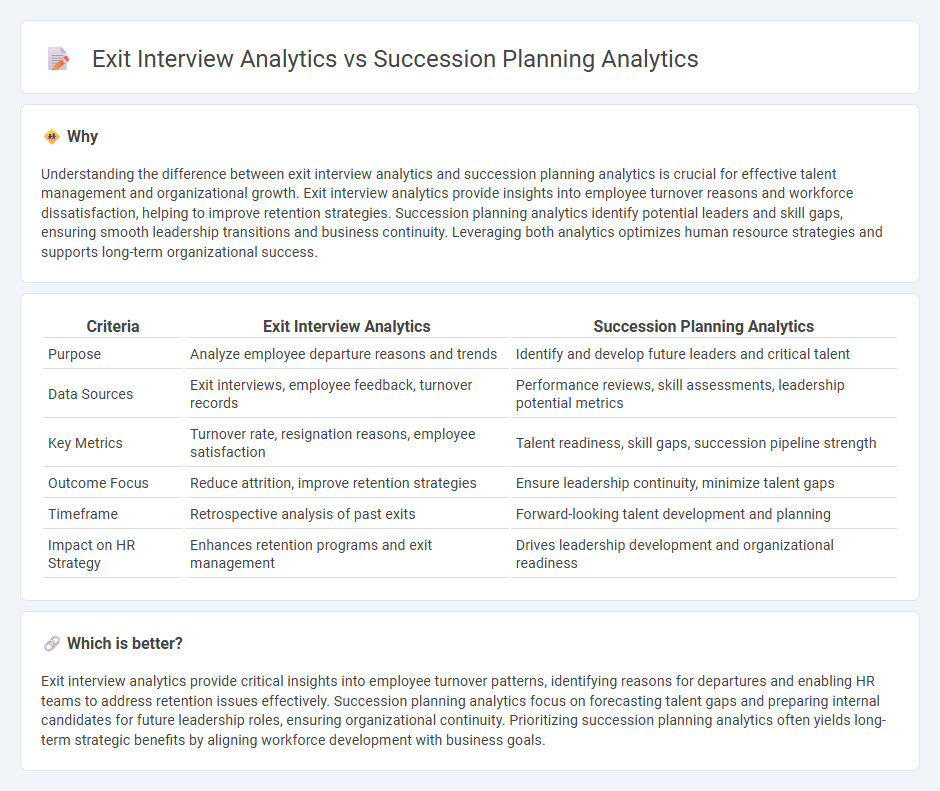
Exit interview analytics focus on collecting and analyzing data from departing employees to identify causes of turnover and improve retention strategies. Succession planning analytics involve evaluating talent pools and performance metrics to ensure leadership continuity and employee development. Explore how integrating these analytics can enhance your HR strategy and workforce stability.
Why it is important
Understanding the difference between exit interview analytics and succession planning analytics is crucial for effective talent management and organizational growth. Exit interview analytics provide insights into employee turnover reasons and workforce dissatisfaction, helping to improve retention strategies. Succession planning analytics identify potential leaders and skill gaps, ensuring smooth leadership transitions and business continuity. Leveraging both analytics optimizes human resource strategies and supports long-term organizational success.
Comparison Table
| Criteria | Exit Interview Analytics | Succession Planning Analytics |
|---|---|---|
| Purpose | Analyze employee departure reasons and trends | Identify and develop future leaders and critical talent |
| Data Sources | Exit interviews, employee feedback, turnover records | Performance reviews, skill assessments, leadership potential metrics |
| Key Metrics | Turnover rate, resignation reasons, employee satisfaction | Talent readiness, skill gaps, succession pipeline strength |
| Outcome Focus | Reduce attrition, improve retention strategies | Ensure leadership continuity, minimize talent gaps |
| Timeframe | Retrospective analysis of past exits | Forward-looking talent development and planning |
| Impact on HR Strategy | Enhances retention programs and exit management | Drives leadership development and organizational readiness |
Which is better?
Exit interview analytics provide critical insights into employee turnover patterns, identifying reasons for departures and enabling HR teams to address retention issues effectively. Succession planning analytics focus on forecasting talent gaps and preparing internal candidates for future leadership roles, ensuring organizational continuity. Prioritizing succession planning analytics often yields long-term strategic benefits by aligning workforce development with business goals.
Connection
Exit interview analytics provide critical insights into employee turnover reasons, which directly inform succession planning analytics by identifying potential skill gaps and leadership voids. Analyzing patterns in exit data allows Human Resources to forecast talent shortages and develop targeted succession strategies to maintain organizational stability. Integrating these analytics improves workforce retention and ensures a smoother leadership transition.
Key Terms
Talent Pipeline
Succession planning analytics evaluates internal talent readiness by analyzing skill gaps, potential successors, and development trajectories to strengthen the talent pipeline and ensure leadership continuity. Exit interview analytics gathers qualitative and quantitative data on employee departures to identify retention risks and improve workforce stability. Explore how integrating these analytics can strategically optimize talent pipeline management.
Turnover Reasons
Succession planning analytics identifies patterns and competencies linked to employee turnover, helping organizations anticipate departures and prepare talent pipelines efficiently. Exit interview analytics gathers qualitative and quantitative data on turnover reasons directly from departing employees, providing insights into workplace issues and opportunities for retention improvement. Explore how integrating both analytics enhances strategic human resource management and reduces unexpected turnover risks.
Leadership Development
Succession planning analytics identifies potential leadership gaps and monitors talent readiness to ensure smooth organizational transitions. Exit interview analytics reveals reasons behind leadership turnover, offering insights into retention challenges and areas for improvement. Explore how integrating both analytics enhances strategic leadership development initiatives.
Source and External Links
10 Critical Succession Planning Metrics for 2025 - Visier - Succession planning analytics uses AI-powered metrics like successor coverage, bench strength, and time-to-fill to proactively assess leadership readiness, identify talent gaps, and ensure continuous strategic workforce planning in dynamic business environments.
How to Use Technology and Data for Effective Succession Planning - Technology and data analytics transform succession planning by identifying high-potential talent through AI-driven assessments, building leadership pipelines with personalized digital learning, and enabling objective, future-proof leadership development.
Data-Driven Succession Planning for Improved Performance - Data-driven succession planning mitigates biases, improves talent development, boosts employee engagement, and aligns leadership continuity with business goals by leveraging analytics for objective decision-making and targeted development.
 dowidth.com
dowidth.com